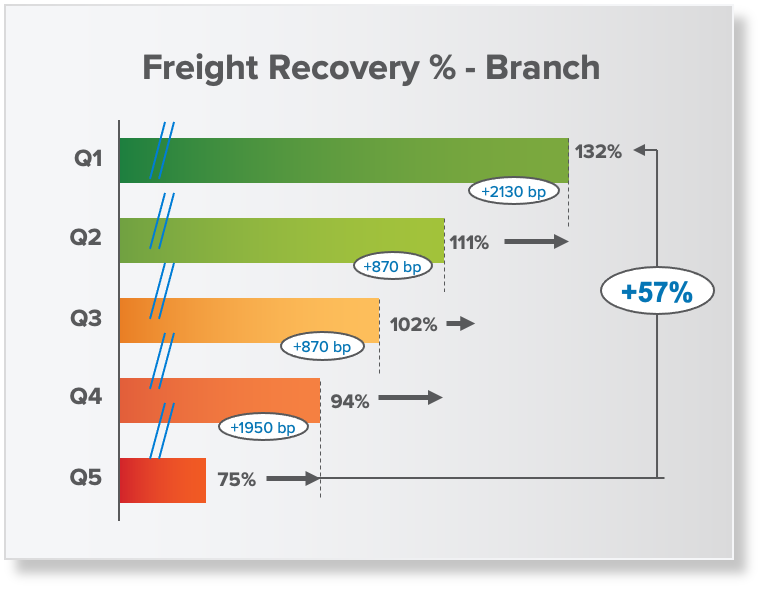There is a silent but growing profit drain leaking away at wholesale distributors this year, and according to experts, it’s likely to double next year and beyond. For the average distributor with an EBIT of four percent, it could potentially reduce their profitability by 60 to 150 basis points, or 15 to 25 percent. However, for a select group of companies, it will increase profitability by the same percentages. What’s going on here?
The often-overlooked matter of freight recovery is coming to a head. Shortages in labor and containers are just some of the factors that have led shipping prices to skyrocket. Global supply chains are at a historic level of disarray due to current economic conditions.
Here are a few challenges that global supply chains are facing today:
- Inflationary pressures
- Trade disputes
- Tariffs
- Supply constraints
- Labor shortages
- Transportation industry consolidation
- Increased demands from expanded e-commerce
- Accelerating construction demand
Depending on the freight type and routes involved, lead times and delivery costs have expanded by 100 percent or more. Historically, special inbound freight, outbound freight (including local deliveries), and drop-ship freight costs represent between two and five percent of revenue for a typical distributor. Due to inflationary forces, those numbers likely already have or will soon double to between four and 10 percent of revenue.
Freight costs account for a large portion of distribution expenses, but few companies have clear visibility into, or a handle on these costs. Today’s supply chain circumstances serve as an opportunity to recover margin by optimizing your freight. This article will discuss how elite companies have mastered freight recovery and are in position to experience a “gold rush” as costs increase.
The Current Logistics of Freight Recovery
Many distributors struggle to recover freight from their customers. There’s a lot of complexity to manage between the diversity of freight types and carriers, route economics, expedite fees, fuel surcharges, and separate-line-item freight charges that are often invisible.
The task of mastering this complexity is often delegated to the branches, warehouse employees and customer service reps within the organization. The net result? Typically, only 70 percent of total freight costs from customers are recaptured, leaving shareholders to pay the balance of 30 percent. That remaining balance of absorbed freight would historically amount to 60 to 150 basis points on revenue, translating into 15 to 37.5 percent of EBIT for an average distributor.
Freight recovery varies from branch to branch by 15 points or more from quintile to quintile. An elite branch may attain 130 percent freight recovery (a for-profit freight scenario); while an average branch may attain 75 percent or less freight recovery.

Due to the inflationary forces described earlier, that loss is and will continue to double: 30 to 75 percent of EBIT. Clearly, distributors who fail to invest in the tools, processes, and technologies of freight recovery optimization will experience long-term declines in profitability.
Controlling Freight Cost is the Key to an Optimized Supply Chain
Today’s freight environment contributes to what we refer to as a stark Tale of Two Cities. While this is the worst of times for many due to rising costs, it’s the best of times for companies who have sharpened their cost recovery strategies. These elite distributors are experiencing a “gold rush” opportunity: as their freight costs rise, so does their EBIT, potentially by the same percentages at which their less-fortunate peers’ profitability will fall. How are they doing that?
In short, freight is often (not always) a profit center instead of a cost center for elite distributors. Here are a few of the processes elite distributors have implemented to achieve this:
- Tighter accounting and control of the diversity and complexity of freight expenses incurred.
- A profile of customers, products, fulfillment models, and freight/carrier types for sensitivity to freight recovery charges.
- Adjusted product cost bases to reflect differential freight intensity.
- A freight recovery strategy that’s integrated with their pricing strategy, providing new options for tactical freight recovery.
Elite companies have truly built freight pricing architectures that optimize the pricing of freight to their customers. In many cases, they are fully leveraging freight recovery modules within their ERP systems (such as Epicor, Infor, NetSuite, Tribute, etc.) to implement an optimized freight architecture. As a result, they are commonly recovering 120 to 140 percent of their targeted freight costs. Historically, at freight levels of two to five percent, their surpluses would amount to 40 to 200 basis points, or an increase of 10 to 50 percent of their baseline EBIT of four percent. With expenses currently or soon doubling, their surpluses from freight will double as well, to potentially 20 to 100 percent of EBIT.
Master Freight Recovery to Experience the Gold Rush
2022 promises to bring strong increases in freight costs for most distributors. Whether those increases will slash or boost profitability depends on the architecture for freight recovery that a company has in place. This inflationary period will yield an invigorating gold rush for those who invest the time, resources, and organizational bandwidth to master the freight recovery challenge. For those who continue using broken processes, missing analytics and inadequate tools, this inflation will further tighten their already-thin margins.
We can help you navigate and master complex pricing situations, regardless of economic conditions. Learn ways you can boost profitability when cost increases occur, such as mastering freight recovery.

